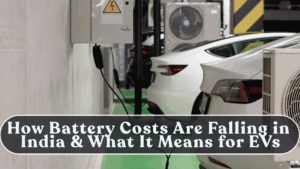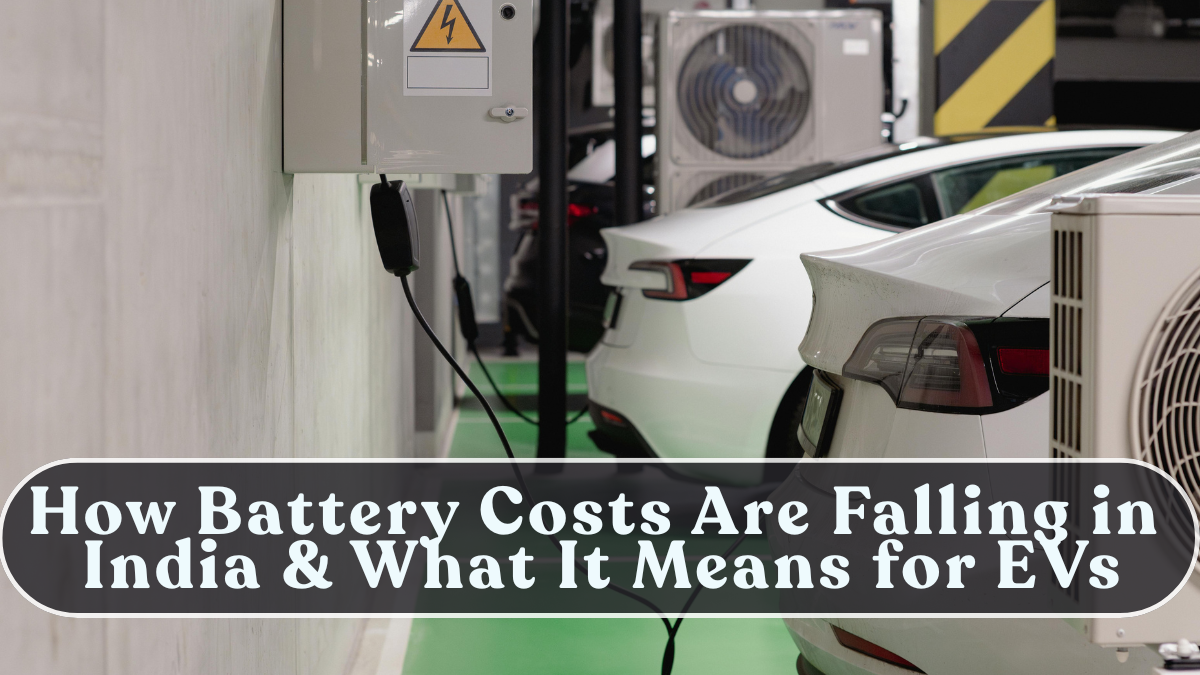Battery prices — once the biggest obstacle to electric vehicle adoption — are now falling rapidly in India, reshaping the country’s EV affordability landscape. As lithium prices drop and local manufacturing ramps up, Indian EVs are becoming more accessible than ever before. This shift is expected to redefine the automotive market, consumer demand, and the pace of India’s transition to clean mobility.

The Turning Point: Why Battery Costs Are Dropping
In 2015, lithium-ion batteries cost more than $700 per kWh. By 2025, the cost is expected to fall below $100 per kWh, a milestone that makes EVs competitive with petrol and diesel vehicles. Several key factors are driving this reduction:
-
Falling Raw Material Prices:
Global prices of lithium carbonate, nickel, and cobalt have declined by 40–50% since mid-2023 due to increased mining output and better recycling methods. -
Local Cell Manufacturing:
India’s PLI scheme for Advanced Chemistry Cells (ACC) has led to the establishment of large-scale factories by Ola Electric, Reliance New Energy, and Exide Energy. -
Technology Innovation:
New battery chemistries like LFP (Lithium Iron Phosphate) and Sodium-Ion are reducing dependency on expensive materials while improving lifespan and safety. -
Economies of Scale:
As EV adoption grows, mass production is driving down per-unit manufacturing costs.
These combined trends are setting the stage for the next wave of EV affordability across India’s two-, three-, and four-wheeler segments.
Impact on EV Prices in India
Battery packs account for 35–45% of an EV’s total cost, so even a small price drop has a huge impact.
-
Electric scooters like Ola S1, Ather 450X, and TVS iQube have already seen price cuts of ₹10,000–₹25,000 in 2024–25.
-
Electric cars such as Tata Nexon EV and MG ZS EV are expected to get cheaper by ₹1–1.5 lakh by mid-2025.
-
E-rickshaws and last-mile EVs, which rely heavily on battery affordability, are experiencing record adoption in Tier 2 and 3 cities.
| Year | Average Battery Price (per kWh) | Approx. EV Price Drop |
|---|---|---|
| 2020 | $137 | — |
| 2023 | $110 | ₹30,000–₹40,000 |
| 2025 (expected) | $92 | ₹60,000–₹1,00,000 |
| 2030 (projection) | $70 | ₹1.5–₹2 lakh |
This downward trend is making EVs price-competitive with ICE vehicles, even without heavy subsidies.
India’s Local Battery Manufacturing Push
To reduce import dependence, India is aggressively localizing its battery ecosystem. The ACC PLI program, worth ₹18,100 crore, aims to build 50 GWh of annual cell production capacity by 2027.
Leading participants include:
-
Ola Electric (20 GWh plant in Tamil Nadu)
-
Reliance New Energy (Gujarat Gigafactory for lithium & sodium cells)
-
Amara Raja & Exide Energy (expanding R&D in solid-state technology)
The government’s Battery Swapping Policy 2025 and Green Hydrogen Mission are also expected to complement these developments, boosting energy storage capacity and efficiency.
Lithium and Beyond: The Material Revolution
India’s recent lithium reserves discovery in Jammu & Kashmir and Rajasthan has opened a new chapter in self-reliance. With domestic mining set to start soon, dependence on imports from China and South America could fall drastically.
Meanwhile, startups and research institutions are experimenting with:
-
Sodium-ion batteries for low-speed EVs and grid storage.
-
Solid-state batteries offering higher energy density and faster charging.
-
Recycling technologies that reclaim up to 90% of lithium and cobalt from old batteries.
These innovations ensure that India’s EV growth remains sustainable and cost-effective.
Impact on EV Adoption and the Economy
Lower battery costs have a direct multiplier effect across India’s automotive ecosystem:
-
Broader affordability: EVs now fall within the reach of the middle class.
-
Higher adoption rates: Two-wheeler and fleet segments are seeing a surge in electric conversions.
-
Job creation: Over 2 million new jobs expected in manufacturing, battery assembly, and R&D by 2030.
-
Reduced imports: Local production is helping cut India’s battery import bill by billions annually.
This transition also boosts India’s ambition to become a global EV manufacturing hub, with exports targeting Asia, Africa, and Europe.
Challenges Still Ahead
While progress is strong, India must overcome:
-
High dependency on imported raw materials in the short term.
-
Limited recycling infrastructure for end-of-life batteries.
-
Inconsistent power supply in rural areas for large-scale EV charging.
-
Policy implementation delays that slow down gigafactory timelines.
Addressing these issues will be key to ensuring long-term cost stability.
Future Outlook: Affordable EVs by 2026
Experts predict that by 2026–27, the price of an entry-level EV will be on par with petrol cars in India. Combined with lower running costs and expanding charging infrastructure, this will make EV ownership more economically viable than ever.
Conclusion
The fall in battery prices marks a turning point for India’s EV revolution. With domestic manufacturing, technological breakthroughs, and new material discoveries, India is steadily moving toward mass electrification and export competitiveness. In just a few years, owning an electric car or scooter in India won’t be a luxury — it’ll be the new normal.
FAQs
What percentage of an EV’s cost comes from the battery?
Batteries account for 35–45% of the total vehicle cost, depending on the segment.
How much have EV battery prices fallen in India?
Battery prices have dropped by nearly 30% since 2020, with further reductions expected by 2025.
Who are India’s major battery manufacturers?
Key players include Ola Electric, Reliance, Exide, and Amara Raja.
Will solid-state batteries replace lithium-ion in India?
They’re still in development, but solid-state batteries are expected to enter commercial production by 2028–2030.
How will cheaper batteries impact EV adoption?
Falling prices will make EVs affordable to the mass market, accelerating adoption across all vehicle categories.
